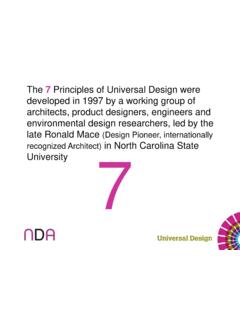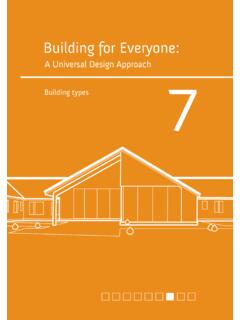Transcription of A Universal Design Approach 1
1 A Universal Design ApproachBuilding for Everyone:External environment and approach1 IICentre for Excellence in Universal DesignCreating an environment that can be used by all people, regardless of their age, size, disability or ability. The National Disability Authority s Centre for Excellence in Universal Design has a statutory role to promote the achievement of excellence in Universal Design in: the Design of the built and external environment product/service Design information and communications technologies (ICT) the development and promotion of standards education and professional development raising awareness of Universal designMore information and updates on the website at.
2 For EveryoneBooklet 1 - External environment and approachThe other booklets from the Building for Everyone series:Booklet 2 - Entrances and horizontal circulationBooklet 3 - Vertical circulationBooklet 4 - Internal environment and servicesBooklet 5 - Sanitary facilitiesBooklet 6 - Facilities in buildingsBooklet 7 - Building typesBooklet 8 - Building managementBooklet 9 - Planning and policyBooklet 10 - Index and terminologyii Contents Objectives Introduction Terminology Design Issues Topographical
3 Constraints Safety and convenience A balance of needs Vehicular Environments Car park provision Car parking spaces Car parking signage Designated car parking spaces Multi-storey and underground car parks Paid parking Setting-down points Taxi ranks pedestrian environments Access routes Drainage Guardrails Changes in level External ramps Handrails Ramp surface and edge protection External steps Surface materials Natural and tempered landscapes Urban environments Street furniture Lighting and signage Placement of street furniture Bins Bollards Gates Drinking fountains Seating pedestrian crossing points Tactile paving surfaces Blister surface for pedestrian crossing points Corduroy paving for hazards Protection of Outdoor Works Construction sites Roadway and pavement maintenance 89A1 Definition of Universal Design 90A2 Human Abilities and Design 90A3 Further Reading 95 List of Illustrations 99 Index 1014
4 Objectives The guidance in this booklet promotes the concept and philosophy of Universal Design and encourages developers, designers, builders and building managers to be innovative and think creatively about solutions that meet the needs of all building objectives of the series of booklets are to: identify and promote best practice with regard to Universal Design of the built and external environment provide best practice guidelines while recognising existing regulations in Ireland provide guidelines that are usable by and accessible to the target audience promote the achievement of Universal Design in IrelandThis booklet aims to.
5 Identify and promote best practice for access to and understanding of the external environment and Approach to buildings with regard to Universal Design increase awareness of, and encourage designers to identify, the needs of all those who require access to the external environment in order to undertake daily activities highlight the wider benefits experienced by all when accessible and Universal Design features of the external environment and approaches to buildings are provided encourage designers to provide Universal Design solutions for the external environment and approaches to buildings that look beyond the recommended requirements of national building regulations5 Introduction This booklet is part of the series Building for Everyone
6 A Universal Design Approach , which aims to provide practical guidance on the Universal Design of buildings, places and Design places human diversity at the heart of the Design process so that buildings and environments can be designed to meet the needs of all users. It therefore covers all persons regardless of their age or size and those who have any particular physical, sensory, mental health or intellectual ability or disability. It is about achieving good Design so that people can access, use, and understand the environment to the greatest extent and in the most independent and natural manner possible, without the need for adaptations or specialised solutions (see full definition in Appendix A1).
7 Why Universal Design ?People are diverse - some are left-handed and some right-handed - and vary in their age, size and functional capacities. Illness or disability (whether temporary or permanent) can also affect characteristics such as a person s mobility, dexterity, reach, balance, strength, stamina, sight, hearing, speech, touch, knowledge, understanding, memory, or sense of direction. A reference list with these booklets indicates some of the key differences in human abilities that should guide the Design of buildings and of outdoor places.
8 (See full description of Human Abilities in Appendix A2).People of diverse abilities should be able to use buildings and places comfortably and safely, as far as possible without special assistance. People should be able to find their way easily, understand how to use building facilities such as intercoms or lifts, and know what is a pedestrian facility and where they may encounter the wide diversity of the population, a Universal Design Approach , which caters for the broadest range of users from the outset, can result in buildings and places that can be used and enjoyed by everyone.
9 That Approach eliminates or reduces the need for expensive changes or retro fits to meet the needs of particular groups at a later is good practice to ascertain the needs of the range of expected users as early as possible, and to check the practicality and usability of emerging designs with a diverse user for one group can result in solutions that address the needs of many others. For example: level entry (Step-free) entrances facilitate not just wheelchair users but also people with buggies; people with suitcases or shopping trolleys; people using walking or mobility aids; and people with visual difficulties larger toilet compartments provide easier access to wheelchair users; those with luggage or parcels; parents with pushchairs or accompanying small children; those using walking or mobility aids.
10 And larger-sized people clear, well-placed signage that uses recognised symbols or pictograms helps people with reading or cognitive difficulties, and those whose first language is neither English nor IrishSometimes one solution will not suit all and a range of options will need to be provided. For example: providing both steps and a ramp where there is a change in level providing parking ticket machines that offer slots at different heights to facilitate use at standing height, sitting height, and by people of small statureThis series of booklets is for architects, engineers, planners, developers, designers, building contractors, building workers, building managers and others involved in designing, commissioning and managing buildings and their surroundings.



